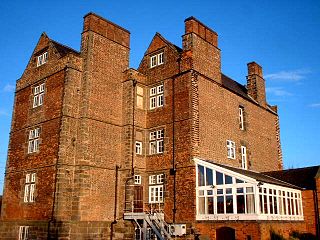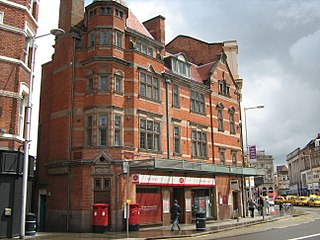
Derbyshire is a ceremonial county in the East Midlands of England. It borders Greater Manchester, West Yorkshire, and South Yorkshire to the north, Nottinghamshire to the east, Leicestershire to the south-east, Staffordshire to the south and west, and Cheshire to the west. Derby is the largest settlement, and Matlock is the county town.

Bretby Hall is a country house at Bretby, Derbyshire, England, north of Swadlincote and east of Burton upon Trent on the border with Staffordshire. It is a Grade II listed building. The name Bretby means "dwelling place of Britons".

South Derbyshire is a local government district in Derbyshire, England. The district covers the towns of Melbourne and Swadlincote as well as numerous villages and hamlets such as Hilton, Hatton, Etwall, Aston-on-Trent, Repton, Weston-on-Trent and Willington. About a third of the National Forest lies within the district.

Chellaston is a suburban village on the southern outskirts of Derby, in Derbyshire, England.

Aston-on-Trent is a village and civil parish in the South Derbyshire district, in the county of Derbyshire, England. The parish had a population of 1,682 at the 2011 Census. It is adjacent to Weston-on-Trent and near Chellaston, very close to the border with Leicestershire.

The history of Derbyshire can be traced back to human settlement since the last Ice Age, over 10,000 years ago. The county of Derbyshire in England dates back to the 11th century.

Derbyshire County Cricket Club is one of eighteen first-class county clubs within the domestic cricket structure of England and Wales. It represents the historic county of Derbyshire. Its limited overs team is called the Derbyshire Falcons in reference to the famous peregrine falcon which nests on the Derby Cathedral. Founded in 1870, the club held first-class status from its first match in 1871 until 1887. Because of poor performances and lack of fixtures in some seasons, Derbyshire then lost its status for seven seasons until it was invited into the County Championship in 1895. Derbyshire is also classified as a List A team since the beginning of limited overs cricket in 1963; and classified as a senior Twenty20 team since 2003. In recent years the club has enjoyed record attendances with over 24,000 people watching their home Twenty20 fixtures in 2017 – a record for a single campaign. The local derby versus Yorkshire at Chesterfield now regularly sells out in advance.

Findern is a village and civil parish in the District of South Derbyshire, approximately 5–6 miles (9.7 km) south of Derby. The population of the civil parish was 1,669 at the 2011 Census.

Shardlow is a village in Derbyshire, England about 6 miles (9.7 km) southeast of Derby and 11 miles (18 km) southwest of Nottingham. Part of the civil parish of Shardlow and Great Wilne, and the district of South Derbyshire, it is also very close to the border with Leicestershire, defined by the route of the River Trent which passes close to the south. Just across the Trent is the Castle Donington parish of North West Leicestershire.

Weston-on-Trent is a village and civil parish in the South Derbyshire district of Derbyshire. The population of the civil parish at the 2011 census was 1,239. It is to the north of the River Trent and the Trent and Mersey Canal. Nearby places include Aston-on-Trent, Barrow upon Trent, Castle Donington and Swarkestone.

Alexander MacPherson,, was an English architect. Although born in Nottingham he worked for the majority of his career in and around Derby, where he had moved in 1880. He served as president of the Nottinghamshire and Derbyshire Architectural Society.

Morley is a village and civil parish within the Borough of Erewash in Derbyshire, England.

The Derbyshire Royal Infirmary was a hospital in Derby that was managed by the Derby Teaching Hospitals NHS Foundation Trust. Following the transfer of community services to the London Road Community Hospital located further south-east along London Road, the infirmary closed in 2009 and most of the buildings were demolished in spring 2015.

Smalley is a village on the main A608 Heanor to Derby road in Derbyshire in the East Midlands of England. The population of the civil parish as of the 2011 census was 2,784.

Edward Anthony Holden was a landowner who lived at Aston Hall, in Aston upon Trent, Derbyshire. He inherited land and bought more starting in 1833. He was High Sheriff of Derbyshire in 1838/9. By the time of his death he had created an estate of over 2,000 acres (8.1 km2) of land in Derbyshire and Leicestershire.

Catton is a civil parish within the South Derbyshire district, which is in the county of Derbyshire, England. Overwhelmingly rural, its population is reported alongside the adjacent parish of Coton in the Elms for a total of 896 residents in 2011. The parish is 100 miles (160 km) north west of London, 15 miles (24 km) south west of the county city of Derby, and 5 miles (8.0 km) south west of the nearest market town of Burton upon Trent. Being on the edge of the county border, it shares a boundary with the parishes of Coton in the Elms, Lullington and Walton upon Trent in Derbyshire, as well as Barton-under-Needwood, Edingale and Wychnor in Staffordshire. Catton Hall, a historic country house and the surrounding Catton Park are notable for hosting several annual events.

St Wilfrid’s Church, Barrow upon Trent is a Grade I listed parish church in the Church of England in Barrow upon Trent, Derbyshire.

St Mary the Virgin's Church, Weston-on-Trent is a Grade I listed parish church in the Church of England in Weston-on-Trent, Derbyshire.

All Saints’ Church, Aston upon Trent is a Grade I listed parish church in the Church of England in Aston-on-Trent, Derbyshire.
Mary Shuttleworth Boden was an activist in the British temperance movement. She was affiliated with the Woman's Christian Temperance Union, British Women's Temperance Association, British Temperance League, Girls' Friendly Society, Women's Union Church of England Temperance Society, Bands of Hope, and the Woman's Auxiliary Union. She donated land to Derby on Bold Lane in memory of her husband which was equipped with sixteen swings as an area for girls, boys and small children to play.




















